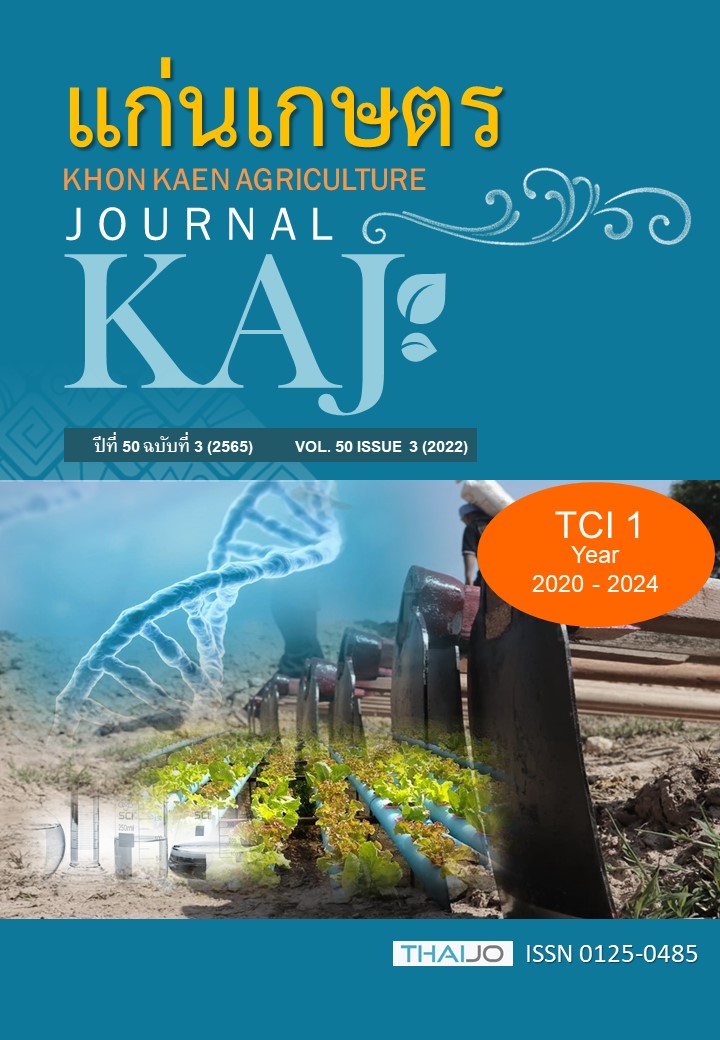การคัดเลือกเชื้อราก่อโรคแมลงไอโซเลตในจังหวัดนครราชสีมาที่มีประสิทธิภาพในการเข้าทำลายหนอนและดักแด้แมลงวันบ้าน (Musca domestica L.)
Main Article Content
บทคัดย่อ
แมลงวันบ้าน (Musca domestica L.) เป็นแมลงพาหะนำโรคและสร้างความรำคาญสู่คนและสัตว์เลี้ยง งานวิจัยนี้มีวัตถุประสงค์เพื่อคัดเลือกหาเชื้อราก่อโรคในแมลงไอโซเลตท้องถิ่นที่มีประสิทธิภาพในการควบคุมแมลงวันบ้านในสภาพห้องปฏิบัติการ โดยการแยกหาเชื้อราก่อโรคในแมลงจากตัวอย่างดินที่เก็บรวบรวมในเขตพื้นที่จังหวัดนครราชสีมา ด้วยวิธี baiting technique ใช้หนอนนก (Tenebrio molitor L.) เป็นตัวล่อเชื้อ ได้เชื้อราก่อโรคในแมลง จำนวน 45 ไอโซเลต (เชื้อรา Metarhizium spp. จำนวน 41 ไอโซเลต และเชื้อรา Beauveria bassiana จำนวน 4 ไอโซเลต) เชื้อราที่รวบรวมได้นำมาทดสอบการก่อโรคให้กับแมลงวันบ้านในระยะหนอน (วัย 2) และดักแด้ พบเชื้อราจำนวน 34 ไอโซเลต และจำนวน 13 ไอโซเลตที่สามารถเข้าทำลายหนอน (4.44 – 97.78%) และดักแด้ (2.22 – 97.78%) ตามลำดับ เมื่อเปรียบเทียบประสิทธิภาพของเชื้อราแต่ละไอโซเลตในการเข้าทำลายแมลงวันบ้าน ที่ความเข้มข้นของเชื้อรา 1x108 โคนิเดีย/มล. เชื้อรา Metarhizium spp. ไอโซเลต NM_SS 9/2 มีประสิทธิภาพในการควบคุมหนอนแมลงวันมากที่สุด โดยมีการติดเชื้อ เท่ากับ 86.67% ไม่แตกต่างทางสถิติ (P>0.05) กับไอโซเลต NM_BAL 7/1 (71.11%) และ NM_NS 7/2 (68.89%) ส่วนไอโซเลต NM_CLPK 4/1 สามารถเข้าทำลายดักแด้ได้สูงที่สุด (60.00%) รองลงมาคือ NM_SN 2/1 (57.78%) จากผลการวิจัยนี้แสดงให้เห็นว่าเชื้อราก่อโรคแมลงไอโซเลตของจังหวัดนครราชสีมามีประสิทธิภาพในการควบคุมแมลงวันบ้านได้ และเหมาะสมที่จะนำไปประยุกต์ใช้ป้องกันและกำจัดแมลงวันบ้านในสภาพโรงเรือนต่อไป
Article Details

อนุญาตภายใต้เงื่อนไข Creative Commons Attribution-NonCommercial-NoDerivatives 4.0 International License.
เอกสารอ้างอิง
คม สุคนธสรรพ์ และกาบแก้ว สุคนธสรรพ์. 2548. แมลงที่มีความสำคัญทางการแพทย์ในประเทศไทย เล่มที่ 1. บริษัท เชียงใหม่ดิจิตอลเวิร์คส จำกัด: เชียงใหม่.
ศิวิลัย สิริมังครารัตน์. 2557. โรควิทยาของแมลงและการประยุกต์ใช้. สาขากีฏวิทยา คณะเกษตรศาสตร์ มหาวิทยาลัยขอนแก่น.
สถาบันวิจัยวิทยาศาสตร์และสาธารณสุข. 2553. ชีววิทยาและการควบคุมแมลงที่เป็นปัญหาสาธารณสุข. บริษัทหนังสือดีวันจำกัด: นนทบุรี.
อาคม สังข์วรานนท์. 2538. กีฏวิทยาทางการแพทย์. โรงพิมพ์สหมิตรพริ้นติ้ง, นนทบุรี.
Abbott, W.S. 1925. A method of computing the effectiveness of an insecticide. Journal of Economic Entomology. 18: 265-267.
Abdel-Raheem, A.M., and B.M. Eldafrawy. 2016. Effect of entomopathogenic fungi as biocides against house fly, Musca domestica L. (Diptera: Muscidae). Journal of Plant Protection and Pathology. 7: 633–636.
Acevedo, G.R., M. Zapater, and A.C. Toloza. 2009. Insecticide resistance of house fly, Musca domestica (L.) from Argentina. Journal of Parasitology Research. 105: 489-493.
Acharya, N., E.G. Rajotte, N.E. Jenkins, and M.B. Thomas. 2014. Potential for biocontrol of house flies, Musca domestica, using fungal biopesticides. Biocontrol Science and Technology. 25: 513-524.
Archana, M., P.E. D’Souza, and J. Patil. 2017. Efficacy of entomopathogenic nematodes (Rhabditida: Steinernematidae and Heterorhabditidae) on developmental stages of house fly, Musca domestica. Journal of Parasitic Diseases. 41(3): 782–794.
Azzam, S, and E. Hussein. 2002. Toxicities of several insecticides to the house fly Musca domestica from different regions in Jordon. Sarhad Journal of Agriculture. 18: 69–75.
Barson, G., N. Renn, and A.F. Bywater. 1994. Laboratory evaluation of six species of entomopathogenic fungi for the control of the house fly (Musca domestica L.), a pest of intensive animal units. Journal of Invertebrate Pathology. 64: 107-113.
Bidochka, M.J., J.E. Kasperskl, and G.A.M. Wild. 1998. Occurrence of the entomopathogenic fungi Metarhizium anisopliae and Beauveria bassiana in soil from temperate and near northern habitats. Canadian Journal of Botany. 76: 1198-1204.
Bugti, G.A., W. Bin, S.A. Memon, G.K., and M.A. Jaffar. 2020. Entomopathogenic fungi: factors involved in successful microbial control of insect pests. Journal of Entomology. 17: 74-83.
Cantwell. G.E., A.J. Noppi, and J.G. Stoffolano. 1976. Embryonic and postembryonic development of the house fly. Agricultural Research Service. United State Department of Agricultural. Washington D.C.
Farooq, M., and S. Freed. 2016. Infectivity of housefly, Musca domestica (Diptera: Muscidae) to different entomopathogenic fungi. Brazilian Journal of Microbiology. 47: 807-816.
Geden, C.J. 2012. Status of biopesticides for control of house flies. Journal of Biopesticides. 5: 1–11.
Humber, R.A. 2005. Entomopathogenic fungal identification. Plant Protection Research Unit US Plant, Soil & Nutrition Laboratory. Las Vegas, America.
Ibrahim, A.A., M.I. Hassan, A.I. Hasaballah, M.A. Fouda, and G.M. Omar. 2016. Evaluation of some entomopathogenic fungi against larvae, pupae and adults of house fly, Musca domestica L. Journal of Nuclear Technology in Applied Science. 4: 103-112.
Iqbal, W., M.F. Malik, M.K. Sarwar, I. Azam, N. Iram, and A. Rashda. 2014. Role of house fly (Musca domestica, Diptera : Muscidae) as a disease vector; a review. Journal of Entomology and Zoology. 2: 159–163.
Jaronski, S.T. 2009. Ecology factors in the inundate use of fungal entomopathogens. Biocontrol. 5: 159-185.
Khan, M.F., and S.M. Ahmed. 2000. Toxicity of crude neem leaf extract against housefly (Musca domestica L.) adults as compared with DDVP. Turkish Journal of Zoology. 24: 219–223.
Merdan, B.A. 2012. Bacillus thuringiensis as a feed additive to control Musca domestica associated with poultry house. Journal of Basic and Applied Zoology. 65: 83–87.
Mishra, S., and A. Malik. 2012. Comparative evaluation of five Beauveria isolates for housefly (Musca domestica L.) control and growth optimization of selected strain. Parasitology Research. 111: 1937–1945.
Mishra, S., P. Kumar, and A. Malik. 2011. Adulticidal and larvicidal activity of Beauveria bassiana and Metarhizium anisopliae against house fly, Musca domestica (Diptera : Muscidae), in laboratory and simulated field bioassays. Parasitology Research. 108: 1483–1492.
Mohammed, A.A. 2018. Evaluation the efficacy of Metarhizium anisopliae and some plant extracts in controlling the housefly, Musca domestica in laboratory conditions. Kufa Journal for Agricultural Science. 10: 1-17.
Mostafa, A.A., and A.B. Zayed. 1999. Resistance of Musca domestica (L) (Diptera: Muscidae) from Gamsa City to some insecticides. Egyptian Society of Parasitology. 29: 193–201.
Mwamburi, L.A., M.D. Laing, and R.M. Miller. 2019. External development of the entomopathogenic fungus Beauveria bassiana on the Housefly (Musca domestica). The Proceedings of the National Academy of Sciences, India, Section B: Biological Sciences. 89(3): 833–839.
Samson, R.A., H.A. Evans, and J.P. Latge. 1998. Atlas of entomopathogenic fungi, Springer, Berlin.
Sharififard, M, M.S. Mossadegh, and B. Vazirianzadhe. 2012. Effects of temperature and humidity on the pathogenicity of the entomopathogenic fungi in control of the house fly, Musca domestica L. (Diptera: Muscidae) under laboratory conditions. Journal of Entomology. 9: 282–288.
Sharififard, M, M.S. Mossadegh, B. Vazirianzadhe, and A.Z. Mahmoudabadi. 2011. Laboratory pathogenicity of entomopathogenic fungi, Beauveria bassiana (Bals.) Vuill. and Metarhizium anisoplae (Metch.) Sorok. to larvae and adult of house fly, Musca domestica L. (Diptera: Muscidae). Asian Journal of Biological Sciences. 4: 128–137.
Uma Devi, K., J. Padmavathi, U.M. Rao, C. Khan, A.P. Akbar, and C.M. Murali. 2008. A study of host specificity in the entomopathogenic fungus Beauveria bassiana (Hypocreales, Clavicipitaceae). Biocontrol Science and Technology. 18: 975-989.
Watson, D.W., C.J. Geden, S.J. Long, and D.A. Rutz. 1995. Efficacy of Beauveria bassiana for controlling the house fly and stable fly (Diptera: Musciadae). Biological control. 5: 405–411.


